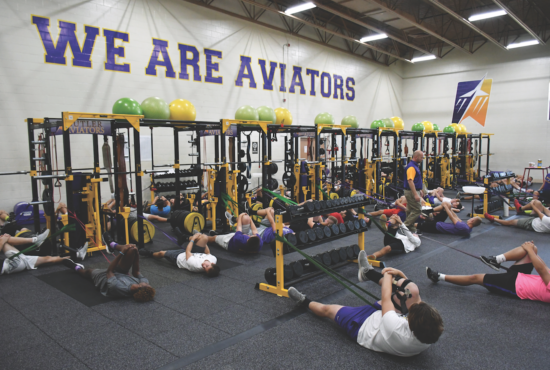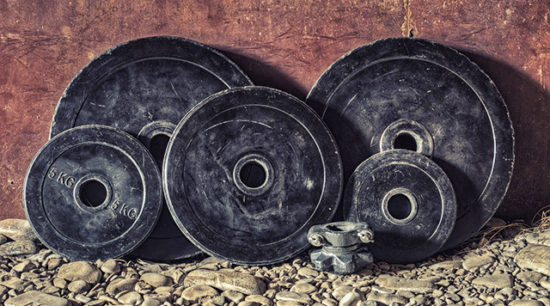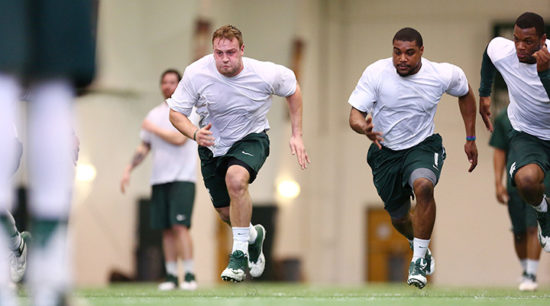Strength & conditioning experts offer their best tips (part 2)
New equipment
At the high school level, it can be quite the process to get approval for a new piece of equipment for the weight room. With tight budgets, sometimes you need to make a comprehensive argument as to why this equipment will benefit your program and how your athletes have a better chance of developing with the latest advancements. Other times, there are outside groups you need to approach in regards to funding. Or, you might be the one charged with finding what’s affordable.
 Vanderbush: If you have strength training classes during the school day, you might be able to get the bulk of your equipment needs met through physical-education funding. Each department within the school is given an allotment of funds to meet their needs. For us, if a team or coach has a request that is specific to their sport, we use a combination of their budget and any funds that are available through the athletic department.
Vanderbush: If you have strength training classes during the school day, you might be able to get the bulk of your equipment needs met through physical-education funding. Each department within the school is given an allotment of funds to meet their needs. For us, if a team or coach has a request that is specific to their sport, we use a combination of their budget and any funds that are available through the athletic department.
Nitka: I have no weight-room budget from the athletic department or physical education department. If I need a piece of equipment, I save up by hosting a golf outing or selling Gatorade, water and juice from a vending machine placed outside the weight room. We also wrote and received a significant grant that helped equip our 5,200-square-foot facility.
McGladrey: To begin with, demonstrate to your athletic director that you have an understanding of the athletic department’s budget and its priorities. Next, the athletic director must be convinced that the equipment being requested is needed to replace defective equipment, would be of considerable benefit to both athletes and students, or is needed to accommodate usage demands of the weight room.
Bull: Equipment spending depends on the size of the purchase. Look to booster clubs (for us, the football booster graciously helps us with training equipment for the football team). We also raise money in our summer training program and coaches clinic, which then is used to purchase smaller items that we need.
McHenry: When it comes time to purchase equipment, get three bids, then go talk with the other coaches to see which bid you want to go with.
Stretching: When & how?
One of the hot topics among coaches and athletes across all sports is when and how to stretch. Most parties are in agreement that the days of standing around, bouncing through a few stretches and jumping directly into competition are over. But, there are still arguments about the impact of stretching prior to practice or an event, as well as how important it is to stretch afterward.
Nitka: Warm-up one day with dots and the next time with a jump rope routine that takes about three minutes. Work on flexibility after your SAQ (speed, agility, quickness days), which for us are Tuesdays and Thursdays.
McGladrey: Use dynamic flexibility before training, static stretching following. Athletes in need of additional flexibility work should engage in proprioceptive neuromuscular facilitation (PNF) stretching prior to training.
Vanderbush: Prior to a workout, have your athletes participate in a dynamic warm-up routine. Static stretching is done at the end of the workout as a part of our cool down. Choose the athlete to lead the post workout stretching routine based on his or her efforts during the workout. In addition to motivation, this method also allows for leadership experience and instruction.
Howard: Use a dynamic warm-up for a dynamic performance.
McHenry: Before the workout, use a dynamic warm-up. Depending on the team, you should also integrate core and static stretch.
Bull: Do a dynamic warm-up before all workouts (speed and agility or strength). Do static and PNF stretches are done at the end of workouts (Bull).
Supervision
One of the most important functions of the strength coach’s job at a high school is to keep all athletes safe. While safety presents itself in a myriad ways, supervision in the weight room is typically a black-and-white area with little gray area for debate.
 Vanderbush: As the strength coach, I oversee what goes on in the weight room, as well as setting up policies and technique instruction. Have your sport coaches actively participate in the process and with everyone on the same page, sending the same message, your expectations are consistent. At times, during initial orientation sessions, develop leadership by assigning upperclassmen to participate in the follow-up teaching and supervision of beginners once the initial instruction is given.
Vanderbush: As the strength coach, I oversee what goes on in the weight room, as well as setting up policies and technique instruction. Have your sport coaches actively participate in the process and with everyone on the same page, sending the same message, your expectations are consistent. At times, during initial orientation sessions, develop leadership by assigning upperclassmen to participate in the follow-up teaching and supervision of beginners once the initial instruction is given.
McHenry: I was hired to be in the weight room before school, teach classes and be there after school, so I am there 90 percent of the time. Many of the coaches bring their athletes to me, check on them and then leave so I supervise the workouts. If I’m absent, the team coach takes their athletes through the workout. In the summer, many of the coaches come in and help out.
Bull: For us, the coaches of every team that use the facility come with the athletes to the workouts some just watch and some are put to use. Assign coaches to stations or areas based on their strengths and weaknesses. Have a brief tutorial session on what you want accomplished and the particular movement patterns on which to focus.
McGladrey: Make the weight room available for athletes only when qualified supervision is present. Individuals qualified to supervise in the weight room are teachers and coaches employed by the school, and screened by you to ensure that they possess adequate knowledge. If necessary, this screening process includes training in weight-room procedures, supervision or resistance training principles and methods.
Nitka: We are very strict with our supervision policy. No student is to train unsupervised. Signs have been posted around the room to remind athletes and coaches. To supervise means to be coaching and evaluating technique. This is part of practice.
Speed/explosiveness
Athletes in every sport need to get faster and utilize their explosiveness. Here are some of the best ways for getting your players moving faster.
Howard: Focusing on fundamental running mechanics with straight-ahead speed, as well as change of direction speed, are critical tools that are developed while simultaneously developing the foundational strength needed to generate speed.
Vanderbush: The best method for developing speed and explosiveness is to have a comprehensive program that includes strength work, a power-hang clean, plyometric training and the use of functional movements. Other than track athletes, sports do not require that athletes run in a straight line. Speed work for most athletes needs to involve first-step quickness and change-of-direction activities utilizing both fixed and reactive parameters.
 Nitka: Learn the basic mechanics of speed development and have your athletes work on starts and 10s, 20s and 40s. A three-mile run does not make your athletes fast.
Nitka: Learn the basic mechanics of speed development and have your athletes work on starts and 10s, 20s and 40s. A three-mile run does not make your athletes fast.
McHenry: Quality over quantity. It’s not how much but how well you perform the drill. Be very picky on technique. If an athlete learns the basics and works on it, they are sure to improve. As they get to be upperclassman, you can increase the complexity of the drill but it is still technique and quality.
Bull: For speed, focus on movement technique, force application and deceleration. For explosiveness, do at least one Olympic movement every day that you’re in the weight room, as well as perform some level of plyometric drill during your speed-agility-quickness (SAQ) days. The level of the plyometric drill varies on the strength of the athlete, where you are in the offseason and how it falls into the training week in the weight room.
McGladrey: Development of speed requires first learning proper sprint mechanics. Load sprint movement patterns with uphill running drills. Training for explosiveness should include a combination of the following: hang cleans, power cleans, snatch, push jerk, plyometrics and medicine-ball throws.
Core training
There are many different takes and strategies to strength the core. Here are some of the best ideas from our panel of experts.
Vanderbush: The best workouts focusing on the core use medicine balls. Have players pass and catch medicine balls while standing on one leg, in a lunge position, while on the move, etc., while using both standard and rotational passes to incorporate the core as it will be used in sport activities. The core is developed naturally in many of the strength-training and athletic-enhancement activities that aren’t necessarily called core training.
Bull: We view the core as everything from mid-thigh to mid-torso, so have your athletes do overhead squats, back extensions and core ball planks at some point during the week. Have all other core work revolve around the needs of the sport (rotational work, for example).
Howard: Include basic structural exercises like squats and deadlifts. Most sports actions are generated from the athletic stance, so core strength needs to be trained from this position.
McHenry: Train core while performing the exercise. Keep the core tight while lifting. Perform over-head squats with very light weight and good technique, as this forces athletes to work on keeping the core tight while going through the full range of motion. Try to do core work with toes on the medicine ball. It works the pillar as described by Mark Verstegen, Vern Gambetta and Juan Carlos Santana. They focus in on hip and torso — not just abs.
McGladrey: Use medicine balls for core training and assign movements that transfer to the sport the athlete plays. Core training is also achieved by emphasizing proper abdominal contraction during execution of lifts.


